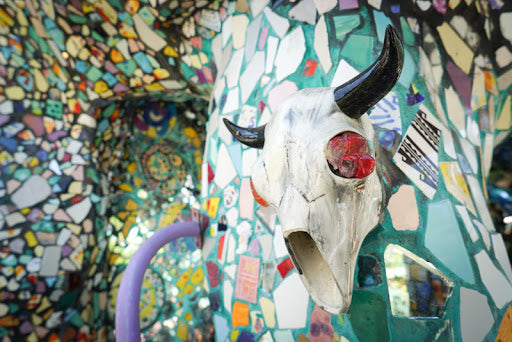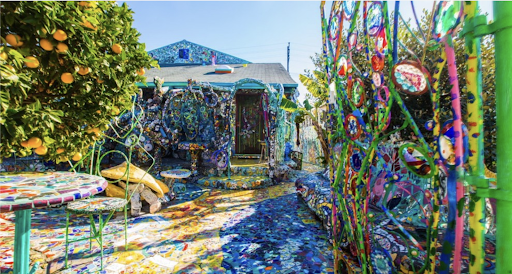We’re continuing our road trip tour of the United States, and checking out the best examples of the widely varied ways in which mosaic art brightens up public spaces. In this segment, we’ll list the must-see locations in Southern California.
Not surprisingly, California has some outstanding pieces that you can easily view. In a land where bright colors, cutting-edge design, and just plain grooviness is always winding its way through the various art forms, mosaic designs has been brought forth in all its beauty. From mystical to historical depictions, get ready to grab your camera and prepare for some magnificent selfies.
The Mosaic Tile House
Venice
This free-flowing work-in-progress is not just a giant piece of mosaic art, it’s also the residence of artists Cheri Pann and Gonzalo Duran. And it’s open for tours!

Image Source:Hidden California
You’ll never wonder if you’ve arrived at the right location for your visit. From street to interior, the mosaic art flows freely from surface to surface. Exterior walls glisten with re-purposed pottery shards, artfully broken ceramic tiles that Pann produced in her own studio, and innumerable hidden elements that invite exploration.

Image Source:Atlas Obscura
The organic shapes and design continue through the courtyard (once a lawn, now an art installation) to the front door. When two artists occupy a space, it’s not always the smooth symbiotic relationship that Pann and Duran have. They each have their own specialties within the arts. Duran paints and honors the bright colors of his native Mexico in his work. Pann is a potter and painter. What started as a fairly small-scale mosaic bathroom tile project has grown to encompass the whole home and surroundings.

Image Source: Atlas Obscura
The local community not only appreciates the Mosaic Art Tile House, but they also nourish it. Neighbors and visitors drop off broken pottery, children bring old toys and found objects, and the art installations shift and change with the flow of contributions. The results are mesmerizing and a bit like a puzzle, as figures and shapes suddenly emerge from the tile patterns. As Duran once told the L.A. Times: “It’s never too much. You can’t go ordinary on top of spectacular. You have to keep trying something different.”

Image Source: Cheri Pann
The Mosaic Tile House is located at 1116 Palms Blvd in Venice. Guided tours can be booked online at the website.
Queen Califia’s Magical Circle, Escondido
Anyone who is interested in mosaic abstract art will know the name of Niki de Saint Phalle. The late artist retired to California in 1994 and contributed several of her large-scale works to the area. Her last major project resides in the Iris Sankey Arboretum inside Kit Carson Park. Part sculpture garden, part interactive exhibit, part playground, the colorful mosaic art pieces are both surreal and yet strangely approachable.

Image Source:San Diego Tribune
Meant to be a place for children to play and for families to enjoy, the installation begins with an undulating wall that is topped by snake sculptures.

Image Source: Luxury Sport
The wall is faced with Mexican pebble stones and decorated with ceramic plaques bearing mysterious symbols from Native American rock art and planetary symbols. The snakes (and other sculptures) were made with individually cut pieces of glass and ceramic, providing a glistening, dynamic look to the surfaces.

Image Source:California Through My Lens
Once past the serpents, visitors enter a black and white mosaic art maze of tiles. As far as mazes go, it’s meant to be fun, not scary. Once through, the entry to the courtyard arises.
Central to the open area is Queen Califia herself. The fabled Amazon queen now rules over a group of 8 other sculptures from her eagle throne, which towers over guests.

Image Source:Joe Orman
8 individual totems depict native influences and mythology as they relate to California history. Look closely, and you’ll see Pre-Columbian, Mexican, and other influences. Kingfishers, snakes, and animal-headed figures rise up to 21 feet in the air.

Image Source:Captured Emotions
The installation was finished a year after de Saint Phalle’s death. It took 4 years to complete this mosaic art. It’s free to the public and located at 3333 Bear Valley Pkwy, Escondido.
Waterfront Park, San Diego
Another set of de Saint Phalle sculptures can be viewed at the County Administration Center. As long-term loans from the Niki Charitable Art Foundation, they will be on view for several more years.

Image Source:KCET
Like the other sculptures, these installations are meant to be touched and explored. Their shapes invite children to crawl inside and through the pieces. The artist felt strongly that the mosaic art should not be held separate from the public, and her family feels that the accessibility of these public pieces would please her.

Image Source:KCET
The pieces include her Serpent Tree and #19 Baseball Player, which was inspired by famed San Diego Padres right fielder Tony Gwynn.
It’s unusual for sculptures to invite the clambering and play of children and the curious, making these installations a unique way to appreciate mosaic art – as well as a testimony to the durability of this type of material.
The Waterfront Park is an open-air public space that is located in San Diego’s Embarcadero District, 1600 Pacific Highway.
Marciano Art Foundation, Los Angeles
The Former Scottish Rite Masonic Temple is a destination for several reasons. Today, it has been rededicated as a contemporary art museum, with an illustrious roster of artists in rotation. Currently, it hosts over 1500 pieces by 200+ artists, all dating from the 1990s forward. An exhibition of California artists and big names like Yayoi Kusama are excellent reasons to visit the MAF, but it’s the mosaic murals that will dazzle you.
The building’s architect was Millard Sheets. An artist who was a member of the California Regionalist Movement, his work celebrated the daily life of California. He later headed the Millard Sheets Design Firm, which produced incredible mosaic murals and mosaics on buildings throughout the U.S. One of their finest commissions was the Scottish Rite site.
To track down the original mosaic art in the museum is a bit of an adventure, but well worth the effort. Start with the east side of the exterior to see the first piece.

Image Source:Adam Arenson
The impressively proportioned mosaic mural depicts the history of Freemasonry. Or, at least the history up until its arrival in Sacramento, CA. Although the piece is accessible, the scale makes it difficult to see all of it well.

Image Source:Esotouric
Here’s a detail of one section.
Many of the mosaic mural art pieces were removed when the building was sold and renovations began. We’ll tell you where to find the existing pieces. You’ll need to visit the upstairs gallery, and head for the back wall.

Image Source:Marciano Art Foundation
Behind a false wall, a stunning mosaic art remains – just step around to see it. This was the former reading room for the library in the temple. It was more of a “mood piece”, as Sheets described it, showing a forest of ancient trees.
Look around the building, and you’ll still see some of the original Masonic emblems. Stop off in the gift shop to see a signed mural painted by Millard Sheets. The Marciano Art Foundation is located at 4357 Wilshire Boulevard, Los Angeles.
Plaza Church, Los Angeles
Our Lady Queen of Angels Plaza Church on Main Street has a religious mosaic that might make you do a double-take. It looks like it’s been teleported from an ancient cathedral in Italy. There’s some interesting history behind it, as well.

Image Source:You Are Here
Installed in 1981, the piece, titled L’Annunciazione (The Annunciation) was created from Byzantine tesserae from Pietra Santa, Italy by artist Isabel Pick. It honors the early ties to the Catholic origins of the Los Angeles city name.
Back in 1769, the Portola expedition from Spain named the river they camped beside in honor of Jubilee of Our Lady of Los Angeles of the Porciuncula, which had taken place the day before. This mural is a reproduction of the center panel of a 14th century painted mural at a Spanish Basilica with ties to the Franciscan order.
The Hungarian-born Pick also was the artist for another large mosaic piece at the St. Catherine Laboure Catholic Church in Torrance, as well as a number of stained glass mosaic windows at churches in the area.
The piece is easily viewed on the facade of the building, which is located at 535 N. Main Street.
The Ilan-Lael Foundation, Santa Ysabel

Image Source: IlanLaelfoundation.org
If you’re in Santa Ysabel on Father’s Day this year, you’re in luck. The Ilan-Lael Foundation is the home of artist James Hubbell – and Father’s Day is one of the two days every year that an Open House event occurs.
The entire compound is open for the public to view on this day. Although the Foundation offers workshops and other programs, the property is not open for viewing at other times, unless one arranges for a docent-led tour.

Image Source:ilanLaelfoundation.org
The architecture and other landscape elements of the property work in harmony with nature. You may have seen Hubbel’s mosaic art work featured prominently at other locations throughout California, or even Findhorn in Scotland.

Image Source:ilanLaelfoundation.org
The organic style of the architecture creates an experience that is beautiful and perhaps a bit dreamlike.

Image Source:ilanLaelfoundation.org
One never knows where the next piece of mosaic art will show up. It’s often combined with natural light for stunning results.
Parking for the tours is located at the Julian Station: 4470 Highway 78, San Ysabel
We hope you have fun on your hunt for the best in mosaic art in the Southern part of California! We’ve enjoyed sharing our favorites, and hope you’ll include a bit of appreciation for the many types of mosaic on your next vacation.

